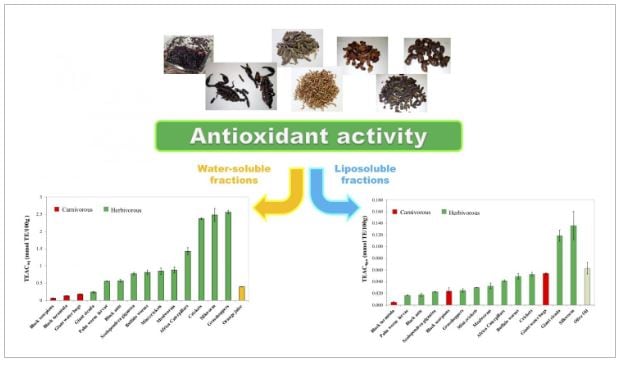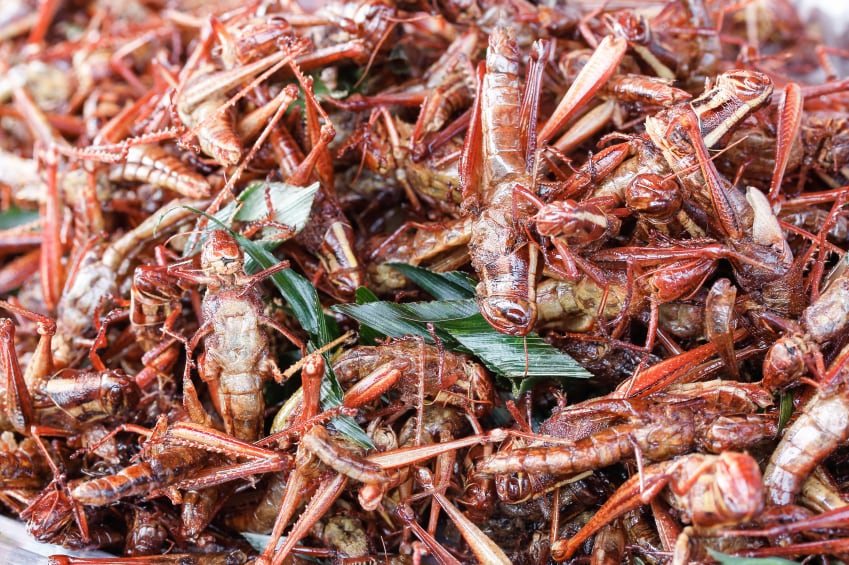Writing in Frontier Nutrition, a team at the University of Teramo in Italy also conclude that grasshoppers, black ants, and mealworms contain the highest levels of total polyphenols.
"Edible insects are an excellent source of protein, polyunsaturated fatty acids, minerals, vitamins and fibre,” says Professor Mauro Serafini, lead study author. "The rest of us will need a bit more encouragement."
“But until now, nobody had compared them with classical functional foods such as olive oil or orange juice in terms of antioxidant activity."
“Antioxidant activity is that free-radical scavenging ability that typically designates a 'superfood' - although this poorly defined term is eschewed by researchers,” he adds.
From a nutritional point of view, insects and invertebrates represent a good source of bioavailable high-quality proteins and essential amino acids,
Insects are also a good source of polyunsaturated fatty acids, minerals such as iron, zinc, and potassium, B vitamins, and insoluble fibre, as chitin.
Researchers attribute its composite nutritional quality as a direct result of plant-based feeding.
However, despite insects’ promise as a nutritional, sustainable food, there is little evidence about the functional properties of insects and invertebrates.
Insect investigations

Dr Serafini and his team began testing a number of commercially available edible insects and invertebrates, from Eatgrub (UK) and Insectemente-votre (FR).
The team removed inedible parts like wings and stings and were then ground into a powder form. Two parts were then extracted for each species: the fat, and whatever would dissolve in water. Each extract was then tested for its antioxidant content and activity.
"For perspective, using the same setup we tested the antioxidant capacity of fresh orange juice and olive oil - functional foods that are known to exert antioxidant effects in humans," Dr Serafini says.
Results reveal the water-soluble extracts of grasshoppers, silkworm, and crickets display the highest values of antioxidant capacity, 5-fold higher than fresh orange juice.
Grasshoppers, black ants, and mealworms, contain the highest levels of Total Polyphenols Index (TPI), followed by buffalo worms, and crickets.
Overall, the majority of extracts, except for evening cicada, giant water bugs, Thai zebra tarantula, and black scorpions, have level of antioxidant capacity higher than fresh orange juice.
"There's a clear trend: the vegetarians have markedly higher antioxidant capacity," says Dr Serafini.
Unknown compounds at work
He points to these comparisons as relevant for the dry, fat-free insect dust, adding that at the same dilution (88% water), grasshoppers and silkworms would have about 75% the antioxidant activity of OJ.
The team also found total polyphenol content - the main source of plant-derived antioxidant activity - followed a similar pattern across species, but was far lower in all insects compared to OJ.
Dr Serafini comments that the results suggests that besides polyphenols, the antioxidant capacity of insects also depends on other, as yet unknown compounds.
“The main antioxidant compounds in orange juice are ascorbic acid and water soluble phenolics, and for olive oil, tocopherols, and amphiphilic phenolics,” the study explains.
“Our results suggest that edible insects are endowed with a peculiar pattern of redox ingredients, ranging from phenolics, proteins as well as unidentified components, able to counteract oxidative stress from water and lipophilic environment.”
Source: Frontier Nutrition
Published online: doi.org/10.3389/fnut.2019.00106
“Antioxidant Activities in vitro of Water and Liposoluble Extracts Obtained by Different Species of Edible Insects and Invertebrates.”
Authors: Carla Di Mattia, Natalia Battista, Giampiero Sacchetti and Mauro Serafini

